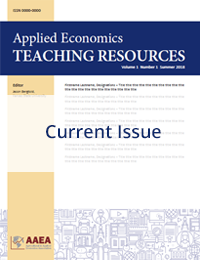Teaching and Educational Methods
Trading Commodity Futures and Options in a Student-Managed Fund
Matthew A. Diersen(a) and Zhiguang Wang(a)
South Dakota State University(a)
JEL Codes: A22, A23, Q02
Keywords: Broker, commodities, experiential learning, speculation
First Published Online: March 24, 2022
Volume 4, Issue 1
Abstract
Student-Managed Investment Fund (SMIF) programs and classes often involve the active management of a stock or equity fund. Complementing these is a unique fund, similar to a commodity pool, that invests directly in agriculture futures and options contracts. This paper presents a trading course that is offered where the class proposes and executes trades in the POET Student-Managed Agricultural Commodities Fund, which is owned by the South Dakota State University (SDSU) Foundation. The course objectives are to: (1) enhance market analysis skills, (2) master trading tools and techniques, and (3) advocate for prudent risk management in trading. Trading drills are used to gain competency in a speculative setting that requires detailed understanding of order entry and exit timing, price levels, and various order types. Real trades are considered including buying and selling futures, options, and combinations of agriculture-related contracts in a margin account. While many of the executed trades are “textbook examples†of how trading should work, the nuances provide teachable moments. The curriculum and fund characteristics are described here to inform other programs that may want to consider adopting a similar course.
References
Bruce, B., and J. Greene. 2014. Trading and Money Management in a Student-Managed Portfolio. Amsterdam: Elsevier Monographs.
Carter, C.A. 2018. Futures and Options Markets: An Introduction. Davis CA: Rebel Text.
Hull, J.C. 2016. Fundamentals of Futures and Options Markets, 9th ed. Boston: Pearson.
Isengildina-Massa, O., and A.F. Ramsey. 2019. “Student-Managed Investment Fund—A New Frontier in Experiential Learning.” Journal of Agricultural and Applied Economics. https://doi.org/10.1017/aae.2019.33
Jones, E. 1993. “Trading Clubs Teach Commodity Marketing.” Journal of Extension 31(4).
Parcell, J.L., and J.R.V. Franken. 2009. “Teaching Options and Futures Trading Through Experiential Learning.” NACTA Journal:11–16.
Purcell, W.D., and S.R. Koontz. 1999. Agricultural Futures and Options: Principles and Strategies. Upper Saddle River NJ: Prentice Hall.
Ramsey, A.F., and O. Isengildina-Massa. 2020. “Evaluation of Learning Outcomes from Participation in a Student-Managed Commodity Investment Fund.” Applied Economics Teaching Resources 2(6):1–13.
Saunders, K.T. 2014. “Option Trading Strategies in a Student Managed Investment Fund.” Advances in Financial Education 12:48–64.
Schroeder, T.C., W.I. Tierney, and H. Kiser. 1995. “Experiential Learning Through Trading Agricultural Commodities.” Agricultural Finance Review 55:89–99.
Yost, J. 2011. “Tips for Organizing an Educational Agricultural Commodity Trading Club.” Journal of Extension 49(1):1–3.
Articles in this issue
Trading Commodity Futures and Options in a Student-Managed Fund
Matthew A. Diersen and Zhiguang Wang
Adaptation of Teaching Strategies During the COVID-19 Pandemic
Luis Moisés Peña-Lévano and Grace Melo
Nudge or Sludge? An In-Class Experimental Auction Illustrating How Misunderstood Scientific Information Can Change Consumer Behavior
Laura A. Paul, Olesya M. Savchenko, Maik Kecinski, and Kent D. Messer
Negotiating for a Grain Elevator Purchase: Valuations of Willingness to Buy and Willingness to Sell
Austin Liepold, Marin Bozic, and Michael A. Boland
Why No Debt? A FRICTO Analysis of the Capital Structure of Cal-Maine Foods Inc.
Carlos J.O. Trejo-Pech and Susan White
The Knowledge and Skills Required to Be a Successful Entrepreneur
Luis Alberto Sandoval


